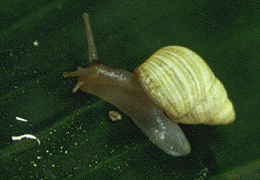
The Wekiva River is a 16.0-mile-long (25.7 km) river in Central Florida, north of Orlando in the United States. It originates in Apopka and joins the St. Johns River, the longest river in the state, in DeBary. The Wekiva River system includes the main stem joined by three main tributaries - Rock Springs Run, Blackwater Creek, and the Little Wekiva River - and about 30 contributing groundwater springs. It is designated as a Florida State Canoe Trail, an Outstanding Florida Water, and an Aquatic Preserve by the Florida Department of Environmental Protection. The Wekiva River system is also one of the two rivers in Florida federally designated as a National Wild and Scenic River for its scenery, recreation, geology, and diverse habitats.

Achatinella apexfulva is a reportedly extinct species of colorful, tropical, arboreal pulmonate land snail in the family Achatinellidae, once present on Oahu, Hawaii. A. apexfulva is the type species of the genus Achatinella. The specific name, apexfulva, meaning "yellow-tipped", refers to the yellow tip of the snail's shell. Inspired from the taxon, the species has been given common names such as yellow-tipped Oʻahu tree snail or Hawaiian yellow-tipped tree snail.
The Wekiwa hydrobe or Wekiwa springs aphaostracon, scientific name Aphaostracon monas, is a species of small freshwater snail, and aquatic gastropod mollusk in the family Cochliopidae.
The dense hydrobe, scientific name Aphaostracon pycnum, is a species of small freshwater snails with a gill and an operculum, aquatic gastropod mollusks in the family Cochliopidae.
The crystal siltsnail, also known as the helicoid spring snail, scientific name Floridobia helicogyra, is a species of small freshwater snail with a gill and an operculum, an aquatic gastropod mollusk in the family Hydrobiidae.
The Ichetucknee siltsnail, also known as the sand grain snail, scientific name Floridobia mica, is a species of small freshwater snail, an aquatic gastropod in the family Hydrobiidae. This species is endemic to Ichetucknee Springs in Florida.
The Enterprise siltsnail, also known as the Enterprise spring snail, scientific name Floridobia monroensis, is a species of very small freshwater snails that have an operculum, aquatic gastropod mollusks in the family Hydrobiidae, the mud snails.
The pygmy siltsnail, scientific name Floridobia parva, is a species of very small freshwater snail with a gill and an operculum, an aquatic gastropod mollusk in the family Hydrobiidae. This species is endemic to Blue Spring in Florida.
The ponderous siltsnail or ponderous spring snail, scientific name Floridobia ponderosa, is a species of small freshwater snail, an aquatic gastropod mollusk in the family Hydrobiidae. This species is endemic to Palm Spring in Florida.
The Seminole siltsnail or Seminole spring snail, scientific name Floridobia vanhyningi, is a species of small freshwater snail, an aquatic gastropod mollusk in the family Hydrobiidae. This species is endemic to Seminole Springs in Florida, United States.
Marstonia castor, common name the beaver pond marstonia, is a species of very small freshwater snail with a gill and an operculum, an aquatic operculate gastropod mollusc in the family Hydrobiidae. This species was endemic to a very limited area of the US state of Georgia, mostly to streams and creeks around Lake Blackshear.
The Ash Meadows pebblesnail is a species of freshwater snail with a gill and an operculum, aquatic gastropod mollusk in the family Hydrobiidae.
Marstonia ogmorhaphe, common names the royal marstonia or royal springsnail, is a minute species of freshwater snail, an aquatic gastropod mollusk or micromollusk in the family Hydrobiidae, the mud snails. This species is endemic to Tennessee in the United States, where it occurs in two streams in Marion County. It is a federally listed endangered species of the United States.
Brune's tryonia, scientific name Tryonia brunei, is a species of very small freshwater snail that has a gill and an operculum, an aquatic gastropod mollusks in the family Hydrobiidae. This species is endemic to the United States (Texas). It was formerly listed as Threatened in 1993/1994 and Data Deficient since 1996 until it was changed to Critically Endangered and possibly extinct in 2012; this is because it is found only in Phantom Lake, Balmorhea Lake, has range of less than 100 km², and was last observed in 1993. A 1991 report by the United States Fish and Wildlife Service also listed it as Endangered and they also later noted the unknown population. It is found in firm substratum and on mud before modification.

Partula is a genus of air-breathing tropical land snails, terrestrial pulmonate gastropod mollusks in the family Partulidae.
C. ponderosa may refer to:
The Amargosa springsnail is a snail in the family Hydrobiidae. It is endemic to the Amargosa River drainage of the southwestern United States. The small snail is known to occur in several near-brackish springs, including the type locality of Saratoga Springs in Death Valley.
Floridobia is a genus of very small freshwater snails that have an operculum, in the family Hydrobiidae, the mud snails.
Wekiva or Wekiwa may refer to:



